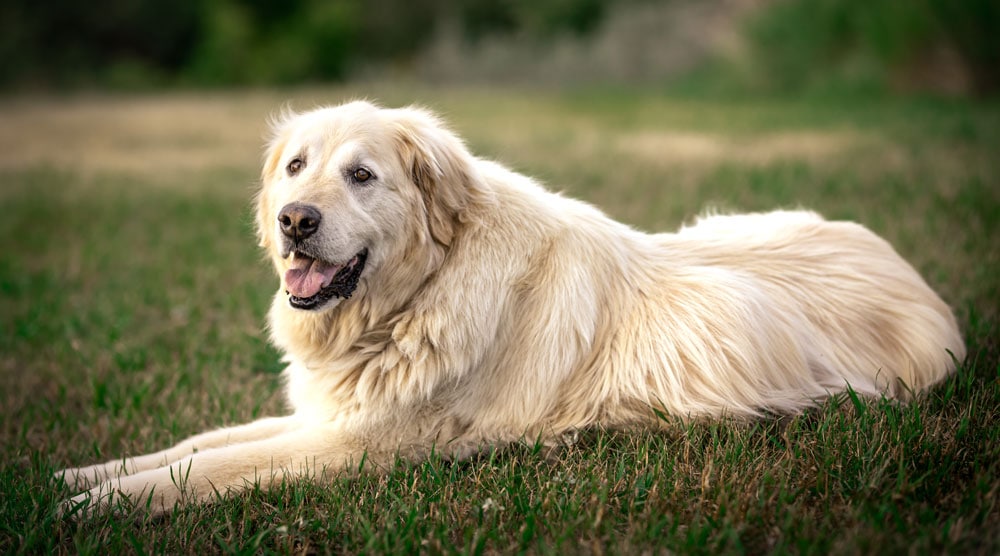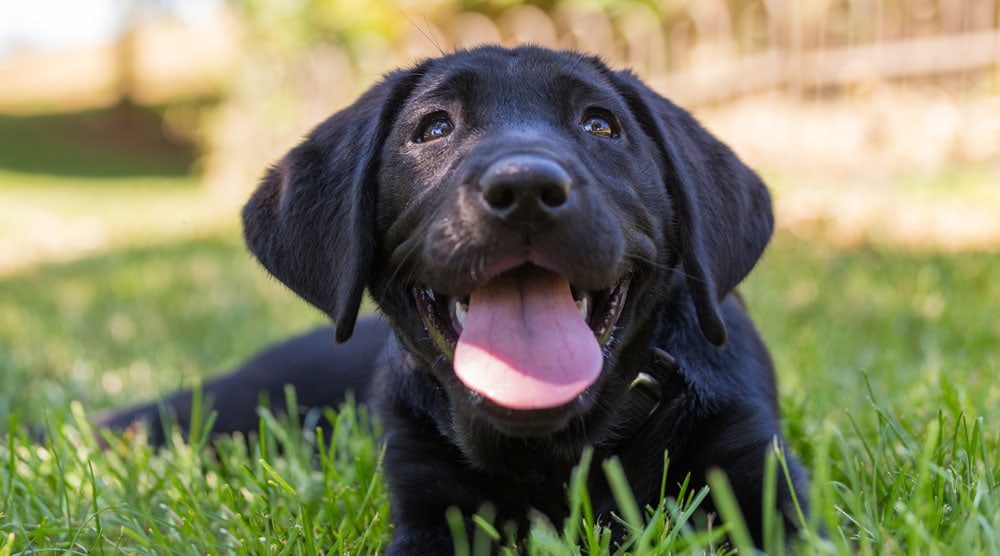Does your dog stop walking and lay down on walks? This issue is more common than many owners realise!
While a dog lying down on walks can be frustrating, it’s important to understand that it’s not a sign of “naughtiness” or “dominance”.
Dogs may lie down because they are scared, exhausted, or in pain. They might also remember trauma from a previous walk or be over-aroused by sensory stimulation.
In this article, we’ll discuss the most common reasons for this behaviour and how to resolve them.
Contents
A Dog Laying Down on a Walk Isn’t Lazy or “Dominant”

When your dog does something frustrating, a common mistake is to label them with human traits. For example, lying down on a walk might be described as “lazy”, “naughty” or “stubborn.”
In the dog behaviour world, labelling dogs with human characteristics is called anthropomorphism – and it’s something responsible dog owners should avoid.
The reason is simple: dogs are not humans! Their goal isn’t to frustrate or annoy you. And they don’t understand or mimic human personality traits.
Instead, laying down on a walk is a response to their current environment, feelings, or emotions.
Similarly, a dog lying down on a walk is not trying to be “dominant” or “take charge”. The idea of dominance in dogs is a myth that’s been debunked many times, as it was based on flawed studies of captive wolves.
For these reasons, you should never punish or scold your dog for lying down on a walk. Aside from hurting your bond, the added stress and fear are likely to make the problem worse.
The key is to work out why your dog is lying down, then take steps to resolve the problem.
9 Reasons Why a Dog Might Suddenly Stop Walking and Lay Down
1. Pain or Injury
Pain due to injury or a medical condition is one of the most common reasons for a dog to stop walking. Some potential causes of pain include:
- Muscle strain or a ligament sprain
- Bone fracture
- A foreign object stuck in the paw
- Hip, knee or elbow pain (often due to conditions such as arthritis and hip dysplasia)
- Puppy growing pains (this is called panosteitis and can cause limping)
Pain is often accompanied by other symptoms. For example, you might see your dog limp before they lay down, or yelp when the injury happens.
Be aware that a dog in pain may not tolerate being touched. However, if your dog is happy to be approached, check the paws for foreign objects. If you can’t see anything, the best option is to take your dog home (or back to the car) and contact a vet.
This is easier for small dogs, as they can be picked up. But if you have a large dog, you’ll need to give them time to recover from the initial shock, then try to lead them back via the shortest route.
For severe injuries to a big dog, such as a broken bone, you’ll need to contact a pet ambulance to come and collect your dog.
2. Exhaustion
There’s a misconception that longer dog walks are always better. While this might be true for highly energetic breeds, all dogs have different exercise requirements.
Many dogs try to push through exhaustion, which can be dangerous. But they may also lie down if they are too tired to continue. Other symptoms of exhaustion include heavy panting, tired body language, and drooling.
Exhaustion on a walk is most common after adopting a new dog, or when owners don’t adjust walking times as their dog ages. It can happen to any dog though, so watch your pet and look for signs of tiredness.
3. Harness Isn’t Fitted Correctly
Harnesses are safer than collars for walking dogs, as they don’t put pressure on the throat. However, they can cause discomfort and pain if they aren’t fitted correctly.
We’ve written a full guide on how to measure a dog harness, but here’s a quick overview to check your pet’s harness is fitted correctly:
- Start with a loosely fitting harness, so it’s easy to place on your pet.
- Tighten the buckles until they are snug, but not tight.
- Check that two fingers can be placed between the dog and the harness.
- Double-check under the armpits, as this is the most common area for rubbing.
4. Nearby Dog or Person
Some dogs lie down when they see an unfamiliar person or dog. There are several potential reasons for this behaviour, but two of the most common are:
- The dog wants to greet the person or dog. They might lie down to show they aren’t a threat, or because you’re walking away from the person they want to meet.
- The dog is fearful of the person or dog. In this situation, the dog may lie down because they don’t want to get any closer, or as a way to cope with anxiety.
As laying down can mean different things, you’ll need to assess other body language signals. For example, lip licking, tense posture, and ears pinned back could all mean your dog is anxious.
5. Scared of the Leash
Leash walking is an everyday event for most canine companions. But some dogs are scared by being leashed or dislike being restricted.
This is most common in rescue dogs or puppies that haven’t experienced leash walking before. If you try to leash these dogs while on a walk, they might lie down due to fear or stress.
For this reason, it’s important to start slowly when you start using a leash. Build positive associations with the leash, so your dog sees it as a positive thing rather than scary.
Here’s an example of how you might introduce a leash:
- Start by leaving the leash near the dog. Allow them to sniff and explore it independently while giving praise and treats.
- When your dog is happy to be around the leash, you can practice putting the leash on for short periods indoors. Don’t walk around yet – just attach the leash and take it off. Again, feed lots of treats during the process to create positive associations.
- Next, progress to attaching the leash for short periods in the garden. Don’t walk around yet, but give treats as you take the leash on and off.
- Now you can start short leash walks around the house, while giving praise and treats.
- Once your dog is happy to walk around the house on the leash, you can move to the garden, before starting short outdoor walks.
Each step should be repeated multiple times before moving to the next stage. If your dog shows signs of fear, move back to a step they are comfortable with.
6. Too Hot or Cold
A dog might lie down if the weather is too hot, cold, or wet, to show they don’t want to continue the walk. In severe cases, the dog may not physically be able to continue with the walk.
It’s vital to monitor your dog and take them home if the weather isn’t safe. Dogs aren’t always sensible when on an exciting walk, so they may continue running past the point of safety.
For example, walking in hot weather is very dangerous for dogs. Dogs can’t sweat through most of their skin, so they rely on panting to stay cool and avoid heat stroke. This isn’t as effective as sweating, which means dogs are prone to overheating.
Heat stroke is a medical emergency. Without quick treatment, it can cause death, so get your dog to a vet as soon as possible. Some common signs of heat stroke to watch out for include heavy panting, tiredness, dribbling, confusion, vomiting, and an unwillingness to continue the walk.
Walking in cold weather can also be dangerous for dogs, particularly those that don’t have thick coats. Dogs in cold conditions can suffer from hypothermia, which is a life-threatening condition.
7. Stress or Fear
Some dogs lay down when stressed or afraid, particularly if they don’t have a way to remove themselves from the situation. This is a coping mechanism.
It’s not always obvious what’s causing stress in dogs, so you’ll need to examine your surroundings to uncover potential triggers. Some examples could be:
- Unfamiliar walking route
- New or unfamiliar noise
- New or unfamiliar scent
- New or unfamiliar physical object
- Other dogs
- Humans
- Other animals (such as wildlife or farm animals)
If your dog is repeatedly lying down due to stress or fear, the problem is unlikely to get better on its own. Instead, you’ll need to uncover the trigger and start a gradual desensitisation program. A dog behaviourist will be able to help you with this.
Tip: Some dogs are fearful of leaving the house. This is a difficult issue that requires patience and the right training strategy to overcome. The best option is to contact a qualified canine behaviourist.
8. Previous Trauma on the Same Route
We’ve already discussed stressed dogs that lie down as a coping mechanism, but this behaviour can also happen due to previous trauma.
If your dog has had a bad experience on a walk, then anything that reminds them could cause a stress response – even if the actual trigger isn’t repeated.
For example, I once knew a dog who would always lie down when he got to a specific part of a walk. The owner didn’t take him to this location very often, but whenever she did, he would react in the same way.
After talking to the owner, we worked out that he had been attacked by another dog in this exact location several years earlier. The trauma of this experience triggered a stress response whenever the dog was taken back – even when there were no other dogs around.
9. Overarousal
In some cases, the range of new scents, noises, other dogs, and wildlife can be overwhelming for a dog. This can cause the dog to lie down as a way to cope.
Overarousal on walks isn’t as common as other reasons on this list. It’s most likely to happen to rescue dogs who may not have been exposed to this level of sensory stimulus.
How to Get Your Dog Moving Again on a Walk

Getting your dog moving again on a walk depends entirely on why they decided to lie down.
Let’s start with what you shouldn’t do though. Never punish your dog for lying down. You also shouldn’t pull your dog along with the leash, or pretend to leave them behind, as both can cause additional stress.
It’s also not a good idea to lure your dog to move with treats. Over time, you could accidentally reinforce that laying down is a way to get a tasty treat.
Instead, here are some tips for getting your dog moving again:
- Start by relaxing the leash, as tension can make the dog feel pressured and more anxious.
- Be patient and wait to see whether your dog starts walking again on their own. Giving your dog time to relax is particularly important if they lie down due to fear or anxiety.
- Try walking in a different direction, as the dog may only be unwilling to move towards a specific location or object. You can also give them the choice of which direction to go (following them is fine at this stage).
- If your dog is comfortable with being touched, get down to their level and give some positive attention. You don’t want to overexcite them, but light reassurance can cause the dog to “reset”. Small dogs who are happy to be touched can also be picked up – this won’t increase their anxiety or fear.
- If your dog will take food, see if you can ask them for a few tricks they already know, such as “paw” or “sit”. Asking for a cue can activate the logical side of the brain, while also providing the dog with a comfortable and reassuring next action.
- Consider whether the walk has been too long, or if the weather isn’t suitable for your pet. Your dog may just be trying to tell you that it’s time to go home!
- If your dog is lying down regularly on walks, it’s time to get a vet checkup to rule out medical issues.
- If your dog is lying down due to fear, contact a canine behaviourist.
Summary
There are many reasons why a dog might lie down on a walk. For example, this behaviour can be caused by fear, exhaustion, pain, previous trauma, or another nearby dog.
Laying down definitely isn’t a sign that your dog is being lazy or difficult though. Dogs only react to their current environment and emotions – they aren’t trying to be frustrating on purpose.
Do you have any questions about why your dog stops walking and lays down? Please let us know in the comments section below.

